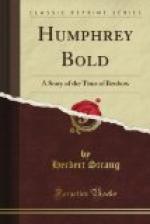But this success spurred me on to devise some means of easing the work yet to be done. The stone was two feet broad; if the wall was ten feet thick there were four more like it still to be removed, and at the same rate it would be three months before we could tunnel through to the air. And thinking of this my heart fell, for there was not room in the cavity left by the stone for two men to work abreast, so that it might indeed be four months before we saw the end of our toil. I determined, therefore, by some means or other to procure a light, by whose aid I could explore the hole and see if the next stone was cemented with the same care.
It chanced that that day we had for dinner a very fat piece of beef. I took advantage of this to pocket some lumps of fat, intending to make a candle with it and a wick composed of some twisted threads from my shirt. The difficulty was to kindle the candle when made, for none of us had a tinder box, though we had steel in our chisel and could easily break a piece of stone from the slab we had loosened.
Tolliday was equal to this, however. He pretended that one of the screws of his fiddle had swelled, so that it would not turn freely in the hole, and he got us to ask one of the soldiers to lend him his tinder box, so that he might make a fire of shavings and heat a skewer red hot, with which to burn away the hole. All unsuspicious, the man lent him the box, which, when it was returned to him had somewhat less tinder in it than before.
That night, and during the remaining weeks of our work, we had a candle. We screened the light very carefully, you may be sure, so that it should not shine through the grating in the wall on the courtyard, and attract the soldiers’ notice.
The stone having been removed, I crawled into the opening, holding the candle, and could scarcely check a cry of joy as I perceived that our task would henceforth be much lighter than I had supposed. At the end of the hole, instead of another stone cemented like the first, as I expected, there was a mass of rubble. I could not doubt that the whole of the interior of the wall consisted of this material, and that we should encounter no more blocks of stone until we came to the outer layer of the wall.
It was easy to understand now why castles deemed impregnable were sometimes battered down. A thickness of ten feet of stone might withstand any bombardment, but once the outer stones were pierced, the lighter material would offer but little resistance to cannon shot.
That was an afterthought, however; my reflection at the moment was that liberty was nearer to us by several weeks. Being acquainted with my discovery, my comrades made no ado when I suggested that we should now remove another of the stones of the inner wall, so that we might more easily get at the rubble. Filled with a new spirit of cheerfulness, they worked with such ardor that in ten nights we were able to lay a second stone alongside of the first.




